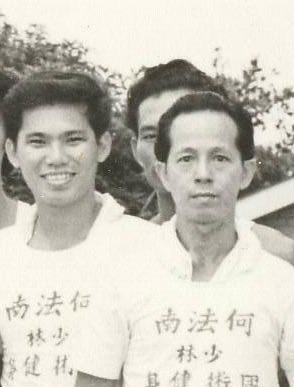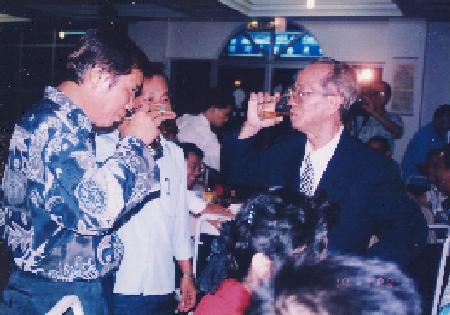FIVE MOST MEANINGFUL LESSONS GRANDMASTER WONG LEARNED FROM GRANDMASTER HO FATT NAM

Grandmaster Wong in his young days and his sifu, Grandmaster Ho Fatt Nam
Question
Dear Sifu, if you were to decide the 5 most meaningful lessons that you have received from Sigung Ho, which ones would they be?
Santiago
Answer
Without doubt and without any hesitation in answering, the most important lesson I have learned from my sifu, Sifu Ho Fatt Nam, was “sum seong si seng”, whch means, word-by-wod, “heart thinks events materialize”.
In the Chinese language, “sum” in Cantonese or “xin” in Mandarin pronunciation, though the written word is the same, usually means the mind. The organ inside your body that pumps blood is called “sam chong” or “xin zhang”, which literally means “storage of the mind” or figuratively “heart organ”.
In Chinese, it is the heart, not the brain, that thinks and feels. It is in English too, before modern science interferes into language. We ask, “How does your heart think”, or “How does your heart feel?”, not “How does your brain think?” or “How does your brain feel?”
So, consciousness is located in the heart. When a neurologist cuts open a patient’s head in a surgical operation, all he sees is the patient’s brain. Interestingly, many psychologists who are experts in psychology, the study of the psyche, which refers to consciousness, are moving away from the heart to the brain!
“Sum seong si seng” or “heart thinks events materialize” has long-reaching consequences for me, though at the time I did not realize its far-reaching effects. This invaluable lesson occurred not in formal classes but over leisurely conversation. If I remember correctly, Simu was with me then.
I asked my sifu, “Sifu, what is the highest art in Shaolin?”
My sifu thought for a little while. I expected the answer to be something like “Dim mak” or “Chin-na”.
But he said, “Sum seong si seng.” I was taken back.
My sifu continued, “Our thoughts are very important. Events materialize according to our thoughts.”
This is a great, invaluable lesson to all of us. We must always have noble thoughts.
This lesson was particularly meaning to our school. When I first established Shaolin Wahnam Association, which later evolved into Shaolin Wahnam Institute, my thought was to preserve the great arts of Shaolin and to pass on their wonderful benefits to deserving students all over the world irrespective of race, culture and religion.
I did not have any idea how this could happen. I did not have any plans, not even immediate plans to expand beyond the then-unknown school out of the little-known town of Sungai Petani. Yet, events materialized according to this noble thought. Now we have more than 60,000 students all over the world, probably the most widely spread chi kung and kungfu school with the largest student population in history.
The second most meaningful lesson from my sifu was “Koi tau sam chet yow shen ming”, or “When you look up three feet, you can find divine beings all around”.
I believe Simu was also with me during this most meaningful lesson which also occurred over leisurely conversation, as my wife always was during my leisure time, i.e. apart from my formal kungfu lessons or teaching in schools, or teaching chi kung and kungfu overseas – even now, more than 40 years after this most meaningful lesson.
I can’t remember what exactly led to this most meaningful lesson. But I can clearly remember my sifu also taught me three crucial steps in having an impeccable conscience.
My sifu said, “A person may make sure no one knows what evil deed he does. He thinks no one knows, but he is mistaken because there are countless beings just above his head. Even if he could cheat these countless divine beings, he cannot cheat his own conscience.”
“There are three steps of being righteous,” my sifu continued. “First, you must be righteous to other people. Second, you must be righteous to heaven and earth. Third, you must be righteous in your own conscience.”
This invaluable lesson is very meaningful to me. I am not afraid anywbere, not because I am combat efficient but because I have lived my life guided by righteousness. Except for an occasion in my childhood greediness even before I started schooling when I stole some used cigarette boxes from a friend (but later he took them back and we remain good friends), I have never done any wrong. If some people, including my students or former students, thought I did something wrong, it was because they held different values.
I have been righteous to other people, to heaven and earth, and in my own conscience. I owed this invaluable lesson to my sifu, and am very grateful to him.
The third most meaningful lesson I learned from my sifu was One-Finger Shooting Zen. It was the exercise that led me to an understanding and development of internal force. Because of internal force, my combat efficiency improved tremendously, promoting me from what I described in another answer as a student’s level to a master’s level.
At this level I could even handle kungfu masters comfortably. I found a qualitative difference between kungfu masters who could spar, not kungfu masters who only demonstrated kungfu forms, and masters of other styles. Kungfu masters who could spar had internal force, though some of them might not realize it as they practiced external arts, and they were careful about their own personal safety. Masters of other styles did not have internal force, and like their own students fought wildly with little concern for their own safety.
The combat techniques of kungfu masters were not sophisticated. But their internal force gave them a big advantage. But when I too had internal force, and I knew sophisticated combat techniques, I reversed the advantage.
Besides combat efficiency, One-Finger Shooting Zen gave me vitality and mental clarity. One-Finger Shooting Zen also gave me longevity, but at that time when I was still young, the idea of longevity did not cross my mind. But the increase of vitality was very obvious. I was literally bouncing with energy.
My next meaningful exercise was Thirty Punches with Stone-Lock. It was an external exercise, but the increase of internal force was remarkable.
I sat on a Horse-Riding Stance, held a pair of stone-locks in my hands, and punched out a fist at a time, then three punches in a sequence, then five. I made the stone-locks myself, but modern dumb-bells are more elegant. When I dropped the stone-locks and performed a kungfu set, or engaged in sparring, I was fast and powerful.
My fifth most meaningful exercise from my sifu was “yiet hei hor seng” or “executing a sequence of patterns in one breath”. One evening my sifu saw me practicing Four Gates. I performed the set pattern by pattern, like what I used to do while learning from Uncle Righteousness.
“Perform a sequence of patterns in one breath,” he said.
That was sufficient. My sifu did not have to demonstrate to me what to do. He did not even elaborate. I just acted on his instruction and found my kungfu performance, including combat application, improved tremendously.
I could progress quite rapidly because of my earlier training in Thirty Punches with Stone-Locks. When I performed a sequence of patterns in one breath, I was fast and powerful.
Executing a sequence of patterns in one breath was very important in combat application. Sequence sparring, which was a crucial factor in winning combat, was possible only when one could execute a sequence of patterns in one breath. If he fought pattern by pattern, his opponent would have time to recover himself.
This invaluable lesson helped me much in daily life. Instead of performing different parts of an activity separately, often resting in between the various parts, I performed all the necessary parts of the activity in one go. Not only I saved time, I also accomplished the activity more successfully.
For example when I gave a public talk to start a chi kung class, I performed all the necessary stages as a sequence and accomplished the task with the formation of a chi kung class. I booked a hall for the talk, bought advertisement in some newspapers, wrote newspaper articles, printed and distributed pamphlets, gave the talk, organized the class, and started teaching it.
It did not mean that there was no time lapse in between the different stages. It was necessary, for example, to have a few days between the appearing of my articles in newspapers and the talk, but all the stages were viewed as a sequence and not as individual parts. I did not sent my articles to newspapers to be published as general knowledge, but as part of the sequence leading to my talk. All the stages were viewed and acted upon as a whole, and not as isolated parts.
Looking at the five most meaningful lessons I had from my sifu, the third generation successor from the southern Shaolin Temple, regarded by many as the pinnacle of kungfu, it is illuminating that the top two involved spiritual teaching and were taught outside of formal classes. These invaluable lessons, the best of the best, lessons that greatly enrich my daily life, were taught to me unexpectedly, neither expected by my sifu nor me. They were taught at the spur of the moment.
The third and the fourth of the five most meaningful lessons involved energy, the second aspect of triple cultivation of form, energy and spirit, or jing, qi, shen in Chinese. They greatly contributed to my internal force, which enhanced my good health, vitality, longevity, peak performance, mental clarity, and spiritual joys.
It is worth noting that the fourth most meaningful lesson was an external exercise, operated by jin, gu, pi or muscles, bones and skin, and not the internal features of jing, shen, qi or essence, spirit and energy. Yet, it produced a lot of internal force, dispelling the misconception that internal force is only generated by internal methods.
The fifth most meaningful lesson involved form. It was executing a sequence of patterns in one breadth. It made all my kungfu performance, both solo practice and combat application, functional and effective. It was not just external. To have good result, I must also be good at the three internal features of the six harmonies, i.e elegance of movement, presence of mind, and energy flow. Of course, the three external features of hands, body and feet in perfect coordination are necessary.
The meaningful lessons were not just how to neutralize a grip or overcome a throw, as some martial artists practicing a mediocre art might think. These combat applications are basic, i.e. anyone practicing a martial art should know them, although the de facto situation today is that most martial artists don’t.
Kungfu may be classified into three categories. Mediocre kungfu enables practitioners to be combat efficient. Good kungfu enables practitioners to be combat efficient, and have good health, vitality and longevity. Great kungfu enables practitioners to be combat efficient, have good health, vitality and longevity, and spiritual cultivation. The ironical situation today is that many martial artists not only are not combat efficient, as revealed by the generous blows they receive in free sparring, but their training is detrimental to their health and spirit.
My five most meaningful lessons from my sifu show what a great art my sifu taught me, for which I am forever grateful. His legacy is now taught and practiced in our School.

Grandmaster Wong drinking to the health of his sifu, Grandmaster Ho Fatt Nam
The above discussion is reproduced from the thread Legacy of Ho Fatt Nam -- 10 Questions to Grandmaster Wong Kiew Kit
LINKS
Courses and Classes
